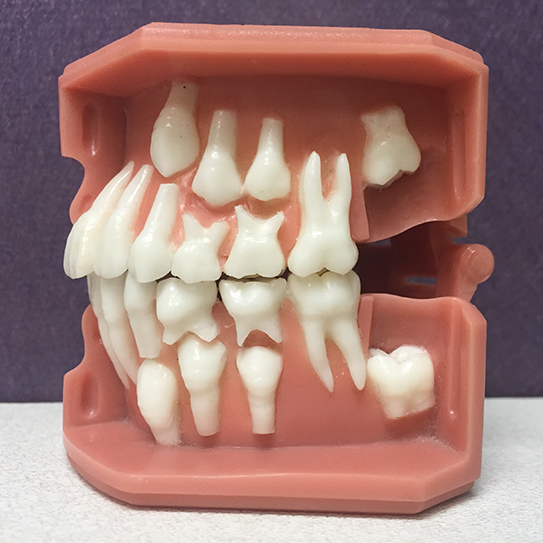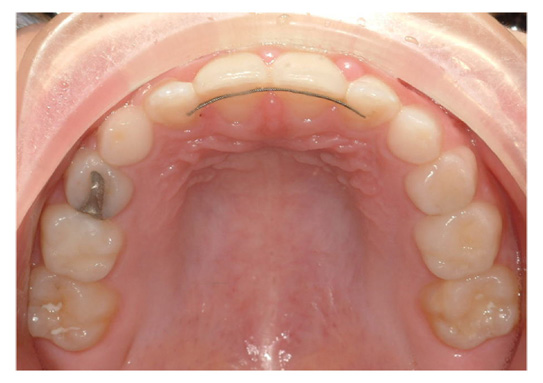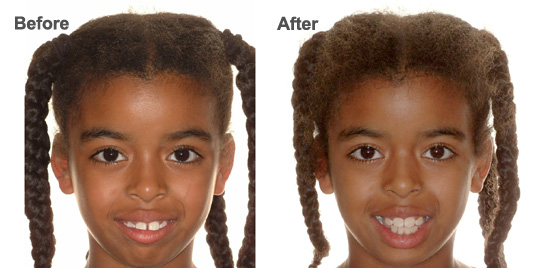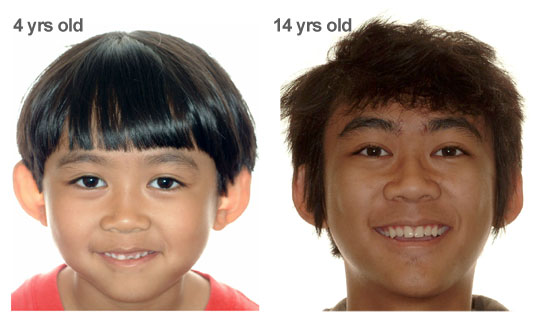January 22nd, 2016

WHAT IF YOU'RE 13 YEARS OLD AND you still have a baby tooth? A baby tooth at age 13 indicates an orthodontic and dental health problem.
Baby Teeth Shouldn’t Be Present After Age 13
Most children lose their last baby tooth by age 12. Girls can be up to two years earlier than boys and lose their last baby tooth by age 10. Boys could lose their last baby tooth as late as age 13. In either case, boys or girls, baby teeth present after age 13 are cause for concern.
If you or your child are over the age of 13 and still have a baby tooth, it is important to have an orthodontic examination with an orthodontist as soon as possible.
4 Possible Problems of a Baby Tooth at Age 13
#1: Your baby tooth is stuck to the bone (ankylosed).
It will not fall out on it's own. The permanent tooth below is unable to push the baby tooth out. This baby tooth needs to be extracted as soon as possible.
#2: The baby tooth is mechanically blocked from falling out.
It is obstructed by crowded side teeth. It can't make an exit, like being too wide for a doorway. There is crowding and braces are needed to allow the baby tooth to fall out or be extracted.
#3: The permanent tooth below is crooked, malpositioned, or sizeways and can't push the baby tooth out.
The permanent tooth in the bone under the baby tooth is is in a poor position and will never come into the mouth without orthodontic treatment. Even if the baby tooth is extracted the permanent tooth will not come into the mouth. Your orthodontist and oral surgeon can bring this impacted permanent tooth into position by removing the baby tooth, exposing the permanent tooth, and then moving it with braces into the mouth.
#4: A permanent tooth is missing.
Below the baby tooth there is a missing permanent tooth. You have tooth agenesis (congenitally missing tooth). You will need to maintain this baby tooth as long as possible and replace it with a dental implant or bridge in the future.
We're Here To Help!
If your general dentist has told you or your child that there is still a baby tooth at age 13, see an orthodontist as soon as possible. To find an orthodontist in you area, contact the American Association of Orthodontist at www.mylifemysmile.com.
At 13 years old, you're not a baby any longer. Take care of your last baby tooth today to find out how you can restore dental health.
Follow Dr. Gorczyca on Twitter @drgorczyca
Gorczyca Orthodontics, www.clubbraces.com.
Tags: orthodontist, dentistry, orthodontics, dental, dentist, Moms, tooth agenesis, Baby teeth, dental health, parents, parenting, baby tooth, tooth fairy, ankylosis, deongenitally, missing tooth
Posted in Blog | No Comments
January 19th, 2016

A GAP BETWEEN YOUR seven year old's front teeth may look cute at 7, but unless you're Madonna, it may not be wanted in adolescence or adulthood. To prepare for your child's future, many 7 year olds have their gap closed by orthodontic treatment.

A gap, or diastema, is common at age 7 when half baby teeth and half permanent teeth are present. Orthodontic treatment at age 7 is called Phase 1 Orthodontic Treatment. It is treatment of half permanent teeth. Additional Phase 2 treatment of all permanent teeth may be needed at age 12.
If a diastema is larger than 2mm, it will not close on it's own. Your orthodontist can help to close this space and get your 7 year old's teeth looking beautiful.

A diastema is often caused by a thick frenum, a piece of skin between the front teeth. Frenums are often hereditary in families. The frenum is best removed once the diastema is closed. The space will be held closed by a wire on the back side of the front teeth.

A periodontist, or gum specialist, will remove your child's frenum to make space closure permanent. Frenum removal is done AFTER the space is closed by your orthodontist.

If you have questions about your child's diastema or frenum, Orthodontist Dr. Ann Marie Gorczyca and Gorczyca Orthodontics can help. Call us at (925) 757-9000 or visit us at www.clubbraces.com.
Goodbaye Gap! Hello happiness! Here's to looking at your 7 year old's beautiful face, teeth, and smile!
Tags: Antioch, orthodontist, dentistry, orthodontics, braces, dental, Moms, seven year olds, Phase 1 braces, fixed retainer, children, kids, parents, parenting, mums, diastema, gap, lingual retainer, pediatric dentistry, pediatrics, Phase 2 braces
Posted in Blog | No Comments
January 14th, 2016

WHEN YOUR FOUR-YEAR-OLD says “Cheese!” at her birthday party, take time to notice if her bite is right.
Most children see a pediatric dentist by age two. By age four, your child may be referred to an orthodontist for severe tooth and bite problems.

There are four childhood conditions treated by an orthodontist as early as age four.
1. Crowded Baby Teeth
Baby teeth should have spacing between them. Overlapped baby teeth are a sign of severe crowding. The permanent front teeth are larger than the baby teeth they replace and need adequate space.
2. Crossbite of Baby Teeth
Crossbite occurs when upper teeth fit inside the lower teeth. If your four year old is experiencing difficulty chewing or bites her cheeks, she may have a crossbite. A crossbite can cause grinding and wearing down of baby teeth. Long term, a crossbite will create an abnormal growth pattern.
3. Lower Jaw Shift with Baby Teeth
Baby teeth out of position can create interference tooth hitting and produce a lower jaw shift. Tooth interference with jaw shifting will wear down teeth and create an abnormal growth pattern.
4. Narrow Upper Jaw with Baby Teeth
A narrow upper jaw indicates narrow nasal passages. This can create open-mouth breathing and sleep problems. Lack of sleep can significantly contribute to difficulty learning at school.

Correction of these early bite problems is of great health benefit to your four year old child. Early treatment by an orthodontist will minimize the need for more extensive orthodontic treatment at a later age.

To Find An Orthodontist Near You...
To find an orthodontist near you, visit the American Association of Orthodontists at mylifemysmile.org. To find a pediatric dentist nearby, you can visit the American Academy of Pediatric Dentistry (AAPD) at mychildrensteeth.org.
This patient was treated by Orthodontist Dr. Ann Marie Gorczyca of Gorczyca Orthodontics, in Antioch, California. For a free consultation call (925) 757-9000.
Make sure your child’s bite is healthy when saying “Cheese!” and that she enjoys eating her birthday cake at age four, or any age.
Tags: dentistry, orthodontics, braces, Antioch braces, Antioch orthodontist, Dr. Ann Marie Gorczyca, bite, crossbite, expansion, Moms, Primary Teeth, Baby teeth, functional shift, parents, sleep apnea, babyteeth, Four-year-olds, parenting, Pediatric, mums
Posted in Blog | No Comments

















